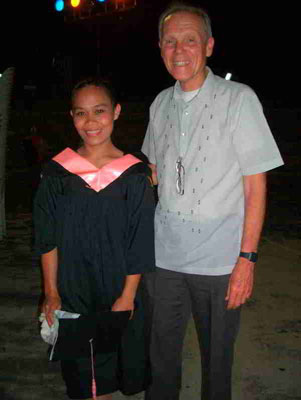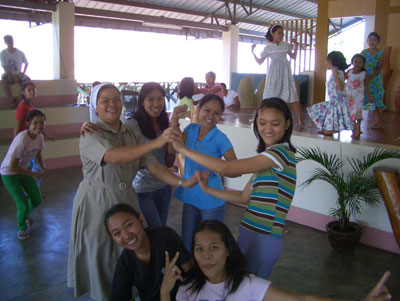An adventure of the heart… in Bacolod
After flying 18 hours on Cathay Pacific from Los Angeles to Manila via Hong Kong, I continued on Philippine Airlines (PAL) to Bacolod, located on the island of Negros in the Philippines.
I was met by Racquel, to whom I had been “introduced” five years before by Rick Zander, a California Rotarian (Rotary International member) living in Bacolod. I had supported Raquel through college, and her graduation from nursing school was the reason for this April ’09 trip. This was our first face-to-face meeting.
Racquel, who lost her parents to drugs and crime at six, grew up in Holy Family Home, one of many orphanages in the Philippines. The majority of the 55 girls living there have families but were taken from them because of abuse at home.
Bacolod is off the normal tourist path. It’s in the Visayas, the central islands of the Philippines, about 45 minutes south of Manila by plane ($60 round trip on PAL or Cebu Pacific). Tickets must be purchased in Manila, but reservations on PAL can, with some effort, be made from the US. The area is justly famed for its tropical beaches and stunning islands.
My far-too-short trip lasted 10 days. Rick drove us from the airport to the Grand Regal Hotel (phone 034 708 5888 or e-mail grandregalhotel_bacolod@yahoo.com), where, with the intervention of Racquel, the quoted room rate of PHP999 (near $20) per night was honored.
The lobby was very nice, including a comfortable restaurant, but my room, though nice, surely was not grand. There was a touch of the third world in the plumbing, plus serious street noise, but it totally met my Motel 6 standards.
During my visit, I took many Racquel-guided jeepney rides. The jeepneys are best described as extended-bed pickups with an open-sided hard top at the cab-roof level. This makes the inside of the bed, where up to 20 passengers sit on two long benches, decidedly low. This was a real challenge for this over-six-footer, but going everywhere at just seven pesos (about 15¢) a ride made it tolerable.
At dinner my first evening, Rick told me a bit about his work and gave me a full agenda of sites to visit. He directs the Indigenous Development Coordinators Foundation, a small NGO working on health, education and agriculture in the Bacolod area. Working nearly alone, he has brought in tens of thousands of schoolbooks, many hundreds of orthopedic devices and a vast amount of agricultural equipment to the area’s most impoverished.
Saturday was Racquel’s big day. We met at my hotel, she in her black graduation robe and I in my new barong Tagalog, the national dress shirt of the Philippines. The inevitable jeepney ride took us to campus for the 7 a.m. baccalaureate Mass.
As a “parent,” I sat with Racquel and shared in the celebration, culminating with my putting Racquel’s pink nursing hood on her — such a wonderful honor.
At 5:00 we were back on campus for graduation, delivered, thankfully, in English. With applause, tears and pictures, it was over. It was a day full of memories of a lifetime and one that will live in my heart forever.
The next day we visited Holy Family Home. I’d seen many pictures over the years but was excited to see the real thing. The high gate opened to an amazing oasis of smiles and flowers. There are not words to describe the warmth of our welcome.
Smiling girls grabbed my hands and took us to Sister Alma, the directress, who was fixing the hair of the smallest girls. There were joyous introductions. Seeing what the miracle of love had brought to these sweet, once-abused girls was wonderful beyond belief.
I started the next day with my first long walk through Bacolod. There were very few traffic signals and the streets were often near gridlock. Crossing the street was serious sport. The rare crosswalk just served to concentrate the targets.
The drivers gave no obvious right of way but, necessarily going slowly, did give a few inches. I never felt seriously threatened.
Over 10 days in Bacolod, I talked to numerous people, finding that all spoke English well, but I never once heard English spoken between Filipinos. The language of conversation is Illago, the local Tagalog dialect.
My ATM card worked perfectly, and with the Philippine peso close to 50 to the dollar, conversions were easy. Most things were half to as little as 10% of the cost you would anticipate in the US, making travel on the island a tremendous bargain for Americans.
After a few more days it was time to return home. I negotiated a PHP450 fare to the airport, where I caught my flight to Manila.
Manila’s airport was a cacophony. I was reluctantly, and with little accuracy, directed to a bus that would get me to the LRT (light rail transit) and my hotel for the night. The bus ride took 15 minutes, much longer than I expected. Then it was up five flights of stairs with my wheelie, which got heavy after two and weighed a ton after five!
The LRT ride to the UN station took just five minutes. On the way out of the station I asked where the Pearl Manila Hotel (phone 63 866 539 8430, www.pearl-manila.com) was and was told, “You’ll see it.” In a block I did.
My modern room ($50 booked directly with the hotel, but you can find better rates through an online booking agent) looked very nice, though the corridor was dark and dirty. Loud clattering from the AC forced me to ask for a new room, which was immediately given.
A long walk yielded the usual dining franchises and numerous higher-price restaurants. I chose a Bacolod chicken restaurant — comfort food! The street was rough, with a good deal of poverty.
I checked out the next day after enjoying the hotel’s very generous buffet breakfast, included in the room rate. The hotel’s desk staff had no idea how to take the LRT back to the airport and discouraged it, but the ride turned out to be a breeze. “Airport” was the last station.
The station guards’ instructions on how to get from the LRT station to the airport, however, were confusing; this was obviously not something that was done often. The station was over a jammed street market with gridlocked jeepneys, so at the first one I came to I asked, “Terminal 1?” Once it was full to 110%, we were off at the pace of a slow walk. It took 30 minutes to go three miles!
The Manila airport was jammed. Check-in went quickly, but clearing Immigration was another story. The officer was writing all the passengers’ names, passport numbers and approval numbers on strips of paper, something I’d not seen in 20 years.
This is a trip others can readily take. I know Holy Family Home (www.billiardphilippines.com/holy_family) and Calvary Chapel Bacolod Orphanage (www.ccbacolod.com) in Bacolod both welcome visitors. You will surely be received as I was. Holy Family Home will even send their jeepney to pick up visitors at their hotel.
Though the orphanages will not ask, a minimum donation of $100 would be appropriate — a very small fee for an adventure that will touch your heart.
Sadly, there are numerous orphanages throughout the Philippines, but most are not close to being as nice as the two I’ve listed.
Similarly, Rotarians welcome those interested in their projects and are generous hosts. Information about Rotary clubs can be found online (www.rotary.org).
I’d be delighted to offer assistance (e-mail c/o ITN) to anyone wishing a similar adventure in the Philippines or in India, Bangladesh or Zimbabwe, where I also have contacts.
ED GRAPER
Goleta, CA


